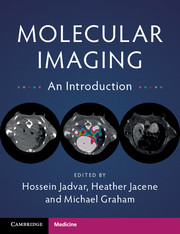Book contents
- Frontmatter
- Contents
- List of Contributors
- Preface
- 1 Instrumentation – CT
- 2 MRI/ MRS Instrumentation and Physics
- 3 Optical and Ultrasound Imaging
- 4 Instrumentation-Nuclear Medicine and PET
- 5 Quantitation-Nuclear Medicine
- 6 Perfusion
- 7 Metabolism
- 8 Cellular Proliferation
- 9 Hypoxia
- 10 Receptor Imaging
- 11 Apoptosis
- 12 Angiogenesis
- 13 Reporter Genes
- 14 Stem Cell Tracking
- 15 Amyloid Imaging
- Index
- References
12 - Angiogenesis
Published online by Cambridge University Press: 22 November 2017
- Frontmatter
- Contents
- List of Contributors
- Preface
- 1 Instrumentation – CT
- 2 MRI/ MRS Instrumentation and Physics
- 3 Optical and Ultrasound Imaging
- 4 Instrumentation-Nuclear Medicine and PET
- 5 Quantitation-Nuclear Medicine
- 6 Perfusion
- 7 Metabolism
- 8 Cellular Proliferation
- 9 Hypoxia
- 10 Receptor Imaging
- 11 Apoptosis
- 12 Angiogenesis
- 13 Reporter Genes
- 14 Stem Cell Tracking
- 15 Amyloid Imaging
- Index
- References
Summary
Angiogenesis plays an important role both physiologically and pathologically and relates to the process of hypoxia-induced formation of new blood vessels from preexisting vessels. It can be useful in some conditions such as collateralization in ischemic myocardium but it is also associated with pathologic conditions such as chronic inflammatory diseases, age-related macular degeneration, and cancer. Tumor growth beyond 1–2 mm is angiogenesis-dependent, which is induced by complex multistep interactions between the tumor and the host (angiogenic switch). Inhibition of angiogenesis may inhibit tumor growth (cytostatic rather than cytotoxic). Early anti-angiogenesis treatment strategies generally resulted in disappointing results which may have been due to flaws in clinical trial design and choice of outcome measures. However, a new generation of anti-angiogenic agents has shown promising results in combination with chemoradiation therapy.
Imaging angiogenesis is critical for the timing of anti-angiogenesis therapy and for the assessment of therapy efficacy. Angiogenesis is a complex biological process and is regulated by abundant molecular pathways including, but not limited to, vascular endothelial growth factor (VEGF), integrins, and metalloproteinases (MMPs). All major imaging modalities (optical imaging, ultrasound, computed tomography, magnetic resonance imaging, single photon emission computed tomography, positron emission tomography) may be employed for imaging some particular feature of angiogenesis indirectly (e.g. perfusion) or directly (e.g. targeted to biologically relevant molecules).
Ultrasound may be used with nontargeted or targeted (to angiogenic markers) microbubble contrast agents for assessment of tumor vascularity and monitoring response to treatment. It is a widely available, relatively low-cost imaging modality that allows portable real-time imaging without ionizing radiation. Computed tomography (CT) with iodinated contrast agents may be employed to assess vascular enhancement over time and diffusion of the contrast material into the extravascular interstitial space. The tissue distribution of contrast material may be modeled to measure such parameters as tissue blood flow, blood volume, and capillary permeability surface area. Magnetic resonance imaging (MRI) provides excellent soft tissue contrast without ionizing radiation. Arterial spin labeling (ASL) and blood oxygenation level-dependent (BOLD) imaging can provide indirect information about vascularity without the use of contrast agents. However, macromolecular contrast material in conjunction with dynamic contrast enhanced (DCE) MRI can be used to assess tumor vascularity and permeability. Research is underway to design and synthesize targeted MR contrast agents that provide direct information about biomarkers involved in angiogenesis such as the VEGF receptor and integrins.
- Type
- Chapter
- Information
- Molecular ImagingAn Introduction, pp. 52 - 54Publisher: Cambridge University PressPrint publication year: 2017
References
- 1
- Cited by



